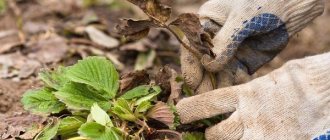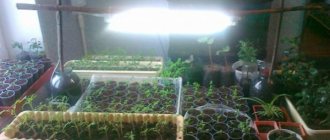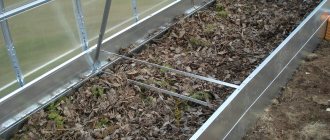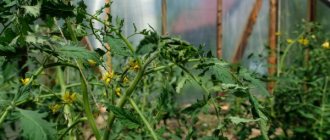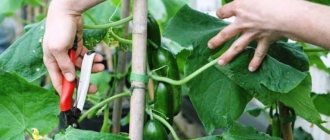Proper preservation of a greenhouse for the winter is the key to its long service life and good harvests. What and when should be done with this building so that it does not turn into a breeding ground for diseases and does not fall apart ahead of time?
First, you need to understand that you have to maintain the greenhouse every year, and it doesn’t matter what model you have. Both wooden, film-coated, and polycarbonate and heated greenhouses expect similar work from you, which you should not skip.
Before you begin seasonal cleaning of the greenhouse, remove all plant debris from the greenhouse. At low temperatures, plants will still not produce new flowers and ovaries, but they will interfere with you. In addition, repair everything that was assembled, remove supports, bush holders and laid paths or bed limiters.
Rinse and dry the irrigation system
When water freezes, it can break pipes and connections, which means that the irrigation system, if you have one, needs to be dried out for the winter. However, before you start blowing out the pipes, clean and disinfect them. This can be done using a solution of orthophosphoric acid or the drug Pekacid and its analogues. Fill the system with it and leave for 2-3 hours, then rinse with strong pressure with clean water and dry.
If there are barrels of water in the greenhouse in the summer, empty them and disinfect them with a similar product, and leave them empty for the winter. It is also advisable to remove and remove drip tapes from drip irrigation systems.
Cleaning beds from mulch and plant debris
For the winter, all foreign debris that has accumulated over the season is removed from the greenhouse:
- Mulch, weeds, dried flowers and shoots, cuttings of dressing material;
- Tops and fallen leaves, wormy and rotten fruits infected with diseases are raked from the beds;
- When cleaning the greenhouse in the fall and preparing it for the winter, yellowed bushes of tomatoes, cucumbers, eggplants or peppers are carefully dug out along with the rhizome. Phytophthora spores and other dangerous pathogens settle on the roots and are not afraid of frost, so they cannot be left in the ground.
Paths lined with brick or pieces of roofing felt are swept and watered with a hose, and weeds sticking out of crevices are cut out with a flat cutter.
Important! Dry and diseased plants are burned outside the site to ensure that germs do not spread to neighboring beds.
Change or disinfect the soil
The soil in the greenhouse is actively exploited, accumulating the remains of fungicides, insecticides, fertilizers and salts. Because of this, within a few years it becomes unsuitable for growing plants and turns into a breeding ground for diseases and pests. The best solution would be to change the soil every 2-3 years. It is necessary to remove a layer 25-30 cm thick (on the bayonet of a shovel), and before this you need to remove the mulch, if any.
If it is impossible to replace the greenhouse soil, it will have to be revived. To begin, disinfect the soil with biological products that, in addition to suppressing microorganisms, heal the soil, for example, Fitosporin-M, Fitocid®-r, Baikal EM-5, Baktofit, Trichoderma Veride 471, etc. They are introduced into the ground two weeks before autumn frosts to a depth of 5-10 cm. In the spring, the treatment can be repeated. Then add 40-50 kg of compost or rotted manure to each square meter and carry out a deep two-level digging. Then water the soil with preparations that accelerate the decomposition and humification of plant residues.
For those who are not afraid to put in extra effort, building warm compost beds in the greenhouse is a good option. To do this, a layer of fresh manure 15-25 cm thick is added to the dug trenches, a layer of plant residues 25-30 cm thick is added on top, and at the end 20 cm of soil or ready-made compost is added. During the fall and early spring, the contents of the trenches will begin to decompose, and in the spring you will receive a ready-made warm ridge with fertile soil.
- Do-it-yourself warm beds - step-by-step instructions with video
Detailed and visual recommendations for creating warm beds in your garden.
If you cleared the greenhouse from planting at the beginning of September, you can improve the soil in it with the help of green manure. Plant oilseed radish, oats, mustard or other fast-growing, cold-resistant green manure, and just before the cold weather, mow the green mass and incorporate it into the soil.
- What green manures can be sown in the fall after harvesting?
We'll tell you how to improve the soil by planting green manure plants in the fall.
Soil treatment after diseases and pests
There are two approaches to ridding the soil in a greenhouse of pathogenic microflora and larvae of harmful insects - disinfection and replacement of the top layer of soil.
Treating the soil with chemicals is undesirable in a greenhouse, where harmful substances are less actively washed out by precipitation throughout the year, and the inability to use crop rotation often forces such treatments to be carried out for several years in a row. The disadvantage of the second method is its complexity.
Soil disinfection
Soil treatment with chemicals can only be carried out in autumn. If you do this shortly before planting seedlings, the roots of the tomatoes will absorb harmful substances from the soil, some of which will accumulate in the fruits.
If tomatoes are exposed to diseases, it is recommended to spray the soil with one of the following products:
- solution of copper sulfate (10%);
- Bordeaux mixture (10%);
- solution of iron sulfate (2.5%);
- drug "Fitosporin-M" (only if the soil temperature is above 10°C).
To combat the larvae of harmful insects, you need to treat the soil:
- drugs “Trichodermin”, “Fitoverm”, “Gaupsin”;
- 4% bleach (in case of spider mite infestation, the concentration of the solution should be increased to 10%).
Fertilize
It is worth adding not only organic matter to the soil in the fall, but also complex mineral fertilizers. If your greenhouse remains covered all year round and is not exposed to rain and snow, you can apply potash and phosphorus fertilizers as early as September-October. They will gradually dissolve in moist soil, but will not be washed out of it and will be available to plants in the spring. On average, 40-60 g of superphosphate and 25-30 g of potassium salt or potassium sulfate are added per 1 sq.m of soil.
- What fertilizers to apply in the fall - types and dosage
Is it necessary to fertilize the soil with the onset of autumn and after the end of fruiting of country crops? Find out now!
What kind of soil do tomatoes need?
Before you learn how to properly prepare the soil for planting seedlings, you should also become familiar with what the soil for tomatoes should be like. What is the ideal land for tomatoes?
She must be:
- loose;
- rich in organic matter;
- well drained;
- free from various pests;
- easy to heat up;
- rich in minerals (calcium, magnesium, potassium, phosphorus);
- its optimal temperature is 18-20 degrees;
- with pH = 6.0-6.5, but can also be from 5.5 to 6.8.
Table. Basic characteristics of soil for tomatoes.
The most important soil parameters for tomatoes are water permeability and looseness. These plants have a strong, branched root, sometimes going into the soil to a depth of 1 m. Its main part is located in the first 50 cm of the soil. The plant needs a lot of moisture. Lack of water will negatively affect the condition of flowers, ovaries, the size of fruits, and may even lead to the death of the plant. Therefore, the soil must hold and pass moisture well.
On a note! The higher the size of the bush the variety, the less it feels the lack of moisture. But short tomatoes do not tolerate drought very well.
However, overwatering can have a bad effect on the tomato - it can rot and die.
Precursor plants for tomato are not of great importance. But it will still be good if you decide to grow tomatoes where cucumbers or cabbage or other cruciferous plants previously grew. The hero of our article does not like the soil where nightshades, for example, eggplants and potatoes, were fruited and grown before him. Tomatoes grow well where legumes and onions were previously grown. You can also grow radishes and lettuce in front of tomatoes.
On a note! Tomato is an excellent predecessor for almost any vegetable; it leaves behind very clean and high-quality soil without weeds.
In general, the tomato is not picky about the soil, but the better conditions are created for its growth, the greater the harvest it will produce. So you should not neglect either autumn or pre-planting soil preparation.
Wash and disinfect frame and walls
To get rid of fungi, bacteria and wintering pests, the walls of the greenhouse must be thoroughly washed with a soapy solution, both inside and outside. It is worth adding copper or iron sulfate to the solution to make it even more effective.
Then you need to close the greenhouse and light a sulfur bomb inside, placed on a brick or other flat, hard, non-flammable surface. Although the bomb burns for several hours, you cannot enter the greenhouse for three days, so as not to inhale sulfur dioxide. After using the checker, the greenhouse must be thoroughly ventilated, washed again to remove soot, and then add preparations that help restore soil fertility (for example, Baikal EM1, Biocomplex BTU Soil Improver, etc.), because As a result of fumigation, many beneficial fungi and bacteria die along with diseases.
In greenhouses, the frame of which is made of unpainted metal profiles, sulfur bombs cannot be used, because this will lead to corrosion.
Wooden frame parts should be sprayed or painted with a 3% solution of copper or iron sulfate to protect them from rotting and pathogenic fungi. Particularly carefully, with the same solution, it is worth treating joints, crevices, cracks and other secluded places where pests willingly settle down for the winter.
Preliminary preparation
Before preparing the soil in the greenhouse in the fall, it is necessary to carry out general cleaning, remove all remnants of plants and auxiliary materials (garter ropes and wooden pegs). The resulting garbage is a highly contaminated mass, so it is recommended to burn it rather than throw it into the compost heap.
Before disinfecting the soil in the greenhouse, it is necessary to disinfect the entire structure. Many of the pests hide in the cracks between the frame and glass or polycarbonate. It is these places that you should pay special attention to. The most effective preparations for disinfecting a greenhouse are a solution of potassium permanganate or copper sulfate. The concentration of both substances is taken approximately, but not less than 1 tablespoon per bucket of water for vitriol and 1 teaspoon for potassium permanganate. Particular attention should be paid to green mold that has formed on the bottom of the window material; it is best to scrape it off completely. The resulting solutions must be used to treat the frame and glass of the greenhouse. A solution of lime chloride is used to treat wooden structures.
Ventilate the greenhouse
After disinfection, the greenhouse must be ventilated by opening the doors and vents wide. To prevent moisture from stagnating inside, it is advisable to leave the door open throughout the winter, and to prevent the frame from becoming warped, it can be removed completely.
You can completely remove the polycarbonate from the greenhouse and put it in a dry place for the winter.
By the way, some gardeners dismantle the ends of polycarbonate greenhouses for the cold season, and put them back together at the end of February or beginning of March, i.e. 3-4 weeks before the start of work in the greenhouse.
Useful tips
And finally, a few tips on how to make the soil for tomatoes in a greenhouse ideal for growing these crops.
- Unfortunately, the soil is capable of retaining various infections that are dangerous to tomatoes. That is why experienced gardeners recommend periodically changing the place where these plants are grown. Every few years, plant tomatoes in a different greenhouse on different soil.
- Spring preparation of the beds should be carried out no later than 10-14 days before planting the seedlings in the greenhouse.
- If the soil is poor in calcium, then it is necessary to add fertilizers containing this element. A lack of calcium contributes to the occurrence of petal rot.
Remember that the better you prepare the soil for winter, the better the harvest you will get for next fall.
Features of processing greenhouse structures of different types
It is necessary to wash a polycarbonate structure carefully, because if you clean the surface vigorously, you can damage it and deteriorate the quality of the material. When treating the surface during the preparation of a polycarbonate greenhouse for winter in the fall, only soft sponges are used, without the addition of abrasives.
There is no need to disassemble the structure frame or remove the polycarbonate sheets; they can withstand sub-zero temperatures without any problems. But some summer residents dismantle the greenhouse structure in the fall, so as not to spoil the polycarbonate sheets from frost and precipitation.
Important! If there is damage on the surface of the polycarbonate sheets, they must be replaced.
Greenhouse treatment
The film structure should not be left until spring, because frost will negatively affect the film, and gusts of wind and a large amount of fallen snow can tear it. In addition, the soil in a greenhouse without a cover will be saturated with melt water.
The greenhouse film must be removed from the frame before frost!
And before removing, the film must be washed. If plant diseases are observed, disinfect with fungicidal solutions or a sulfur bomb. After processing, you need to wash the film again with a clean liquid and let the greenhouse structure dry. And only then carefully remove the film, placing it for storage in any outbuilding.
When the grape seedlings were in a greenhouse, when preparing it for winter, the gardener needed to plant them in a permanent place. Or remove the film cover and cover the seedlings separately before the onset of cold weather.
How to prepare a glass greenhouse structure for wintering?
There are no particular differences when processing glass surfaces from the general rules. Glass is washed with a regular solution of laundry soap or using glass surface cleaners.
If damaged areas are found in a glass structure, they must be replaced. If cracks appear in the frames, they are sealed with special putty.
General recommendations
Let us note the features of caring for a greenhouse structure in autumn and winter:
- Tools used indoors (rakes, buckets, watering cans, pruners, glanders, etc.) must also be treated with a fungicidal solution. After the processing is completed, the tool is removed to a dry outbuilding;
- In October, the frame is inspected and checked for stability so that it does not fall apart under the weight of the snow cover. To be on the safe side, you can install metal or wood supports indoors;
- The door must be closed for the winter, otherwise the wind may rip it off its hinges;
- In mid-February, you can throw snow inside the room so that the soil is saturated with melt moisture. There is no need to bring snow before February, as this will create favorable conditions for wintering harmful insects.
In conclusion, it is worth adding once again that a greenhouse, properly prepared for wintering, will certainly delight you with an abundance of harvest next year.

